Wai ora, wai ako: education’s role in drowning prevention
New Zealand has some of the worst drowning statistics in the OECD – what role does the classroom play in bringing them down?
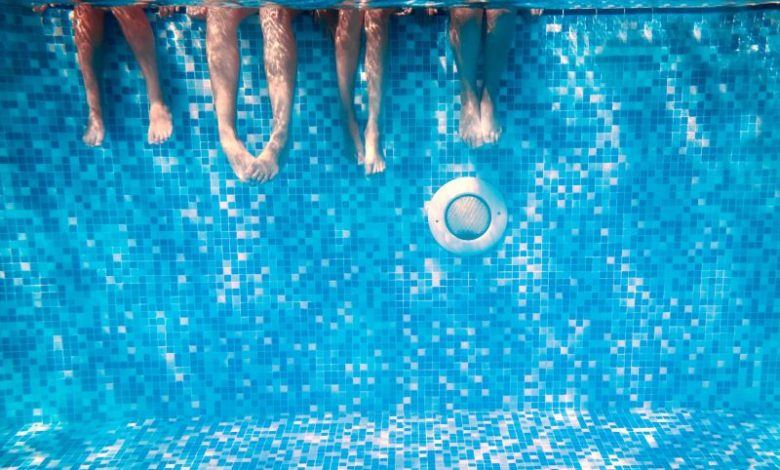
Each year, New Zealand experiences preventable drowning fatalities at a rate that is one of the highest in the OECD. This year alone, we’ve had ten drowning fatalities.
Education around water safety, notably the 15 water competencies, is an essential means of lowering drowning rates – and they can be taught from anywhere, not just at the pool, beach, lake or river.
Read the Term 4 edition of School News HERE
Preventable tragedies
Currently, drowning fatalities are trending upward. In 2021, preventable drowning fatalities increased by 7 percent from 2020, and 13 percent on the five-year average, reaching the highest number of preventable drowning deaths since 2011. Older males are more likely to drown.
Youth are at highest risk in rivers: 25 percent believe that rivers are “not very hazardous” or “not at all hazardous”. River fatalities are typically at 15 – 34 years of age, but serious incidents typically involve 9 – 14-year-olds.
The National Beach and Coastal Safety Report, which provides a ten-year overview of our drowning rates (2010-20), found our fatal drownings were 48 percent higher than Australia, and fatal drownings have increased.
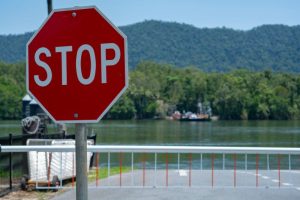
Non-fatal drowning statistics are also grim. There is about a 1:1.8 ratio of fatal to non-fatal drowning incidents. This data only encompasses instances where a non-fatal drowning resulted in a hospitalisation of 24 hours or more, meaning this data only scratches the surface of drowning or near-miss incidents in New Zealand.
In the past, messaging has been focused on swimming to prevent drowning. But in 2007 the International Life Saving Federation (ILSF) made a statement on “Swimming and Water Safety Education” highlighting the importance of more general water-safety education.
Water safety: not just about swimming
In 2017, a research paper titled ‘From swimming skill to water competence: towards a more inclusive drowning prevention future” collated available international research and proposed fifteen water competencies. The paper was an international effort, with one of the authors being Dr Kevin Moran from the University of Auckland.
Many national drowning prevention agencies now adopt the 15 water competencies as best practice.
- Safer entry
- Breath control
- Stationary surface
- Water orientation
- Propulsion (swimming)
- Underwater
- Safe exit
- Personal flotation device (use of PFDs/lifejackets)
- Clothed water (wearing clothes in the water)
- Open water
- Knowledge of local hazards competence
- Coping with risk: awareness, assessment, avoidance
- Assessing personal competency
- Recognising and assisting a drowning person
- Water safety (attitudes and values)
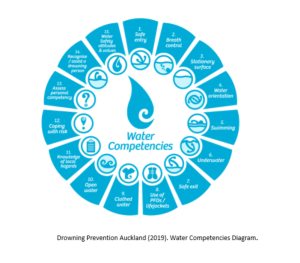
Importantly, not all water safety competencies require practical sessions, meaning water safety can be effectively taught in classrooms.
Ako wai
Drowning prevention organisations, both local and national, have been working to improve water safety education in schools.
Drowning Prevention Auckland is one such organisation. They offer professional learning and development (PLD) for teachers, including support during practical and theoretical sessions. Their website also has free resources that teachers can use to teach water safety anywhere, anytime. Lessons include modules around the 15 water competencies, and some learning is targeted toward higher risk groups.
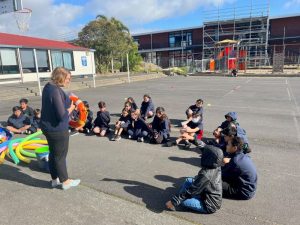
Drowning Prevention Auckland’s Education Team leader Lynley Stewart says it’s important that teachers and schools get behind teaching water competence, and says support is available for teachers who may not know where to start.
“It’s important because we’re surrounded by water. Everyone has a desire to be near water – all our new migrant people coming in are inundated with our amazing waterways and some of them come from landlocked countries. But there are risks associated with water.
“We try to get schools to think holistically about aquatic education. The learning happens in the classroom and the pool. One day students might take up sailing, or boating or fishing, and those are positive recreational outcomes. But they have to be accompanied by knowledge and understanding.”
Helen Meyrick, another member of the education team for Drowning Prevention Auckland, says a good place for educators to start is to simply have a conversation with students about how they are using water. She notes that each school has a unique geography and a regional culture, meaning students are doing diverse activities on and around diverse waterways. This means each school and each group of students has specific needs with water safety education.
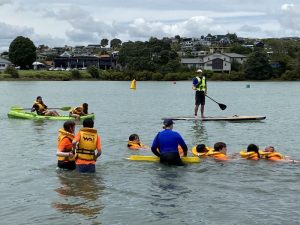
“What are the local areas your kids visit and how are they using that water? That’s what we need to be focusing on, and then you can look at the big picture.”
Meyrick and Stewart also emphasise that water safety learning can and should be taught around existing programmes like swimming lessons. And given the theoretical aspects of learning water competence, these skills can be taught and refreshed anytime during the school year, not just Terms One and Four.
Ideally, to ensure students make connections between theoretical water safety and practical uses, some learning should occur in open water environments like local beaches, or rivers and lakes. However, given health and safety concerns and limited resources, practical sessions on open waterways are not feasible for many schools. But Stewart says that valuable learning can happen at these sites without even going into the water.
“It’s about making a link between the skills taught in swimming pools and classrooms, and real-world environments. If you took your class to a local waterway for a day, and just focused on getting the kids to identify the risks and what they could do to help themselves stay safer, that’s still valuable learning.”
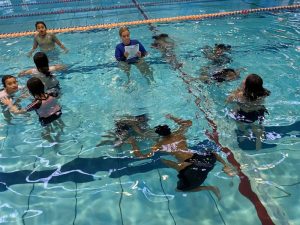
Although organisations like Drowning Prevention Auckland have dedicated educators like Meyrick and Stewart who can teach specialised water-safety sessions at schools, Stewart emphasises the importance of the teacher-led model.
“If we want sustainable change over time, it’s the teacher who’s the best person to lead.”
That’s why professional development and upskilling is such a big focus for the organisation. Teachers looking to upskill and improve their students and their own water-safety skills can contact their local organisations for support.
In the meantime, Meyrick offers some essential water-safety tips for parents and educators alike.
“When it comes to children, active supervision is key. For the younger ones, you need to see them, hear them and be able to reach them. For older children, not so much reaching but you need to be watching: not on your phone, not reading a book.
“As for hazards, people need to think before they get into the water. If in doubt, stay out. If you get to the beach and you’re excited and you’ve been looking forward to it all week, but the conditions don’t look safe – maybe bigger waves, a rip or no lifeguards – stay out.
“It’s not worth it. You want to get home to your family – you can always go again next week.”









